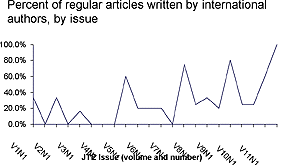JTE v11n2 - It's a Small World After All
It's a Small World After All
When our three children were youngsters, one of their favorite songs was "It's a Small World After All." They played the song over and over until the record finally wore out. I grew very tired of the song and I am thankful in some respects that permanent media like compact disks were not around back in those days. Nonetheless, I was able to satisfy my desire to reminisce about our children when they were young by accessing the Disney site on the World Wide Web and listening to that song.
A new version of that song has been bouncing around in my head recently. I sensed that there was an increasing international presence in the Journal of Technology Education. Petrina (1998) addressed the number of international articles published in the JTE in an earlier, thought-provoking piece. He did not present his analysis, however, over time.
The graph below shows the percent of regular articles (those that go through the refereeing process and appear under the section titled "Articles") by issue, from volume 1, number 1, through the current issue. To be included, at least one of the authors had to be international. Percents were used to plot the graph since the number of regular articles varies from one issue to another. The graph line is quite uneven due to the small range of the values. However, one can easily observe that there are more articles in recent years written by foreign authors.

To analyze the data further, I compared the number of articles written by international authors in the first eleven issues to the number in the most recent eleven issues. The data showed that 16.3% of the articles were written by international authors in the earlier group compared to 41.7% in the latter. This represents a dramatic increase and is evidence of the changing nature of the JTE.
As I completed my analysis, I realized that, by chance, it was quite timely. Every one of the regular articles in this issue was written by an international author. Moreover, the issue contains a book review written by a person from Canada and it is on a book written by a person from Germany. It seems that yours truly is the only non-international entity in the entire issue.
Part of the reason why this has happened is simply due to chance and the timing of manuscript acceptance. The notion, though, of having an international flavor in the JTE was not an accident. Founding editor Mark Sanders maintained a strong international presence among the Editorial Board members from the very beginning and this continues today. But it does not particularly explain away why the international influence has increased in recent years. I have speculated about cause and effect, but I am not prepared to offer my conjectures at this point.
I am confident, though, that the walls that we now tend create in our minds about the national origin of scholarly journals will continue to come down. The increasing number of scholarly journals that are accessible electronically confirms that the Web is truly World Wide. Several journals directly followed the leadership of the JTE in this regard.
Language translators have started to appear on the Web as well, with great promise to eliminate many of the barriers of language. Right now, prospective JTE authors for whom English is a second language are often disadvantaged in the review process. The resources are simply not available to translate and edit a manuscript into English. Plus, such work must yield a high quality product of English prose, not something that simply meets minimal language standards. This impediment will likely dissipate as the language translation technology just mentioned is developed further. The walls will disintegrate even more.
Despite the advances that we have made in our shrinking world, we are not yet able to fully embrace the scholarship that is done outside our native lands. Though there are clear exceptions, it is often true that the majority of the references that appear in a given manuscript cite work that was done in the native country of the author. This is not all bad for it makes us realize that problems and issues are amazingly similar from one country to another and that lines of inquiry somehow take similar, albeit independent, courses. There is also some interesting and pertinent triangulation that can occur. You will note an example in this issue in regard to the design and problem solving process as you read the articles by Gustafson, Rowell, and Guilbert on the one hand, and Williams on the other. In fact, the design and problem solving theme seems to run, to an extent, through all of the articles in this issue even though it was not planned that way. The editorial by Cajas lends a science perspective to design. But is it really a science perspective? What exactly is a science perspective? How high are the walls in our minds around science and other disciplines? How high are the walls that those from other disciplines build in front of us?
The value of reinventing the wheel aside, it seems that we could move ahead more quickly if we would let the world become smaller and used the work that others have already completed. I am confident that this will happen as we fully develop our world-wide electronic library of the future and we regularly meet with one another internationally through the wonders of technology. I think the words of the song and its melody are beginning to have a new, exciting meaning.
References
Petrina, S. (1998) . The politics of research in technology education: A critical content and discourse analysis of the Journal of Technology Education, Volumes 1-8. Journal of Technology Education. 10(1).